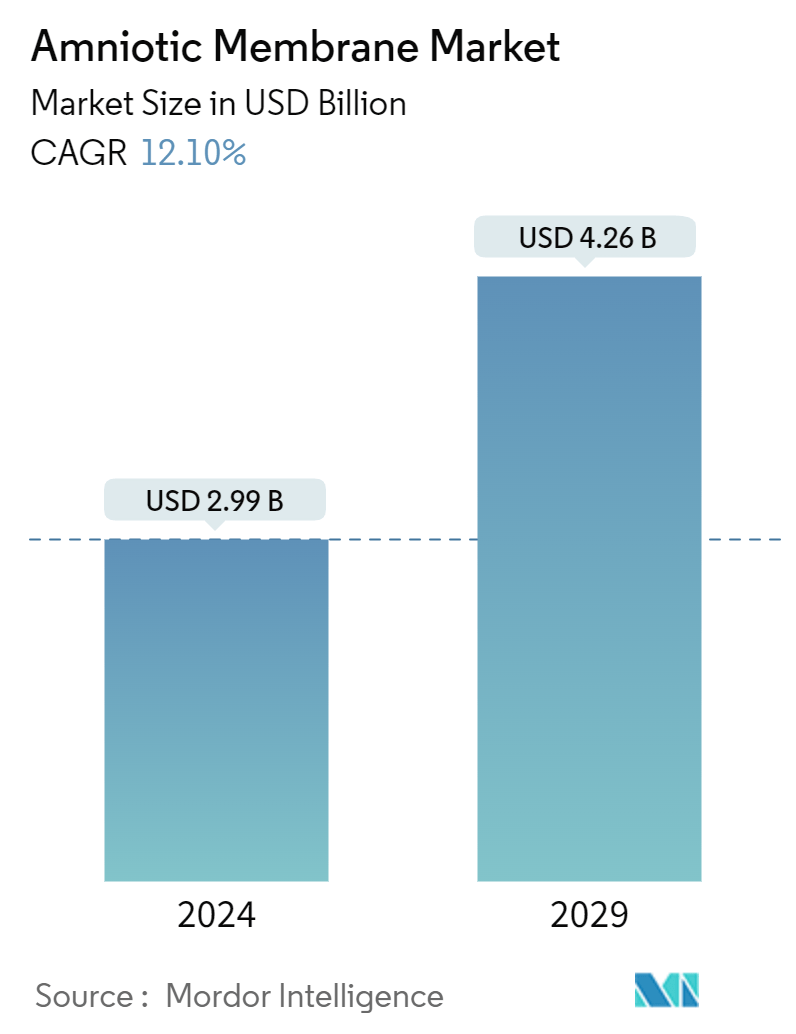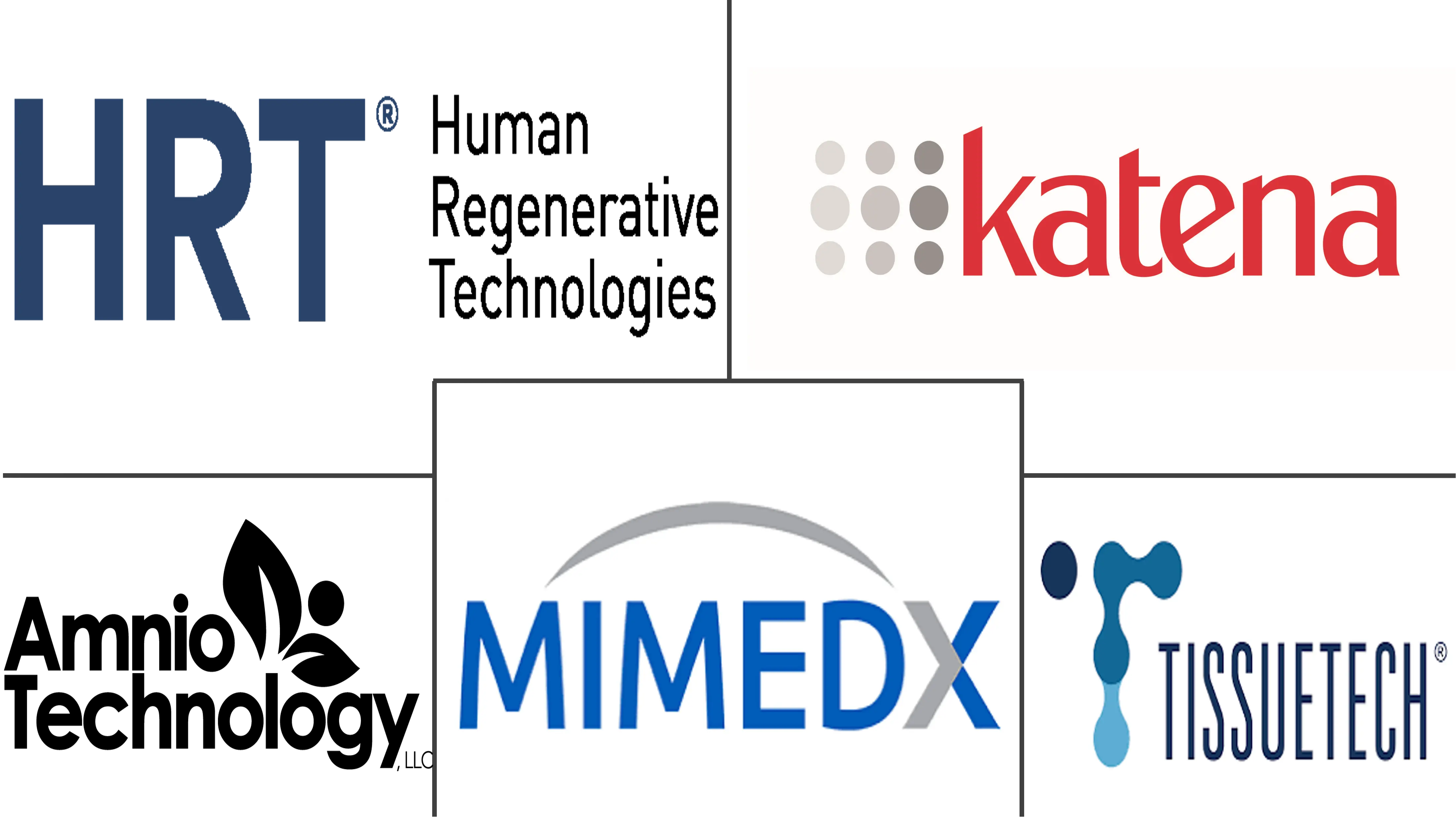Market Size of Amniotic Membrane Industry

| Study Period | 2019 - 2029 |
| Market Size (2024) | USD 2.99 Billion |
| Market Size (2029) | USD 4.26 Billion |
| CAGR (2024 - 2029) | 12.10 % |
| Fastest Growing Market | Asia Pacific |
| Largest Market | North America |
Major Players
*Disclaimer: Major Players sorted in no particular order |
Amniotic Membrane Market Analysis
The Amniotic Membrane Market size is estimated at USD 2.99 billion in 2024, and is expected to reach USD 4.26 billion by 2029, growing at a CAGR of 12.10% during the forecast period (2024-2029).
- Factors such as a rise in accident and trauma cases, increasing awareness about the benefits of an amniotic membrane, and rising research on stem cell biology and regenerative medicines are the major driving factors for market growth. Additionally, the growing number of surgeries performed and rising expenditure on research and development (R&D) in stem cells and regenerative medicine are key factors driving the overall market.
- For instance, as per the data published by the United States Department of Labor in December 2022, over 5,190 fatal work injuries were reported in the United States in 2022, which increased from 4,764 cases compared to the previous year. Burn injuries represent a significant disease burden on the world population, with nearly 9 million injuries and an estimated 120,000-180,000 deaths annually, as mentioned in the research paper published in October 2022. According to the above-mentioned research, almost 18 million disability-adjusted life years (DALYs) can be accounted for burns, with a disproportionate 90% of this burden borne by LMICs.
- Also, in Bangladesh, Colombia, Egypt, and Pakistan, burn injuries account for up to 18% of permanent disabilities, as per the same research above. The amniotic membrane is commonly used to treat up to second-degree burn wounds. Thus, the rising burden of burn injuries globally is expected to create a high demand for the amniotic membrane for the purpose of tissue repair and regeneration, and it is expected to boost market growth during the forecast period.
- The market consists of several major players, and their strategic product innovation is garnering market growth. For instance, in February 2022, Amnio Technology, a global leader in the development of and distribution of amniotic tissue allografts, launched two new palingen membrane products, palingen dual-layer membrane and dual-layer palingen x-membrane. Like the entire family of PalinGen membrane products, the new allografts are minimally manipulated, homologous, and chorion-free. The palinGen membrane and dual-layer palinGen X-membrane are indicated for patients suffering from non-healing acute and chronic wounds and complex or open surgical wounds and burns. Thus, continuous innovation in the amniotic membrane market is expected to drive the market's overall growth.
- In January 2022, Laboratoires Thea SAS, a prominent independent pharmaceutical company in Europe, finalized the acquisition of seven branded ophthalmic products from Akorn Operating Company LLC. This includes AcellFX, which is an acellular amniotic membrane that offers a protective covering for repairing the ocular surface.
- Therefore, owing to the factors above, it is anticipated that the market will witness growth during the forecast period. However, the lack of standardized guidelines and skilled professionals will likely impede market growth.
Amniotic Membrane Industry Segmentation
The amniotic membrane consists of a combination of tissues and cells, and it is the innermost layer of the placenta, which is widely used in ophthalmology and wound healing.
The amniotic membrane market is segmented by enzyme, application, end user, and geography. By enzymes, the market is segmented as cryopreserved amniotic membrane and dehydrated amniotic membrane. By application, the market is segmented as ophthalmology, surgical wounds, and other applications. By end user, the market is segmented as hospitals, ambulatory surgical centers, and other end users. By geography, the market is segmented as North America, Europe, Asia-Pacific, Middle East and Africa, and South America). The report also covers the estimated market sizes and trends for 17 countries across major regions globally.
The report offers the value (USD) for the above segments.
| By Enzyme | |
| Cryopreserved Amniotic Membrane | |
| Dehydrated Amniotic Membrane |
| By Application | |
| Ophthalmology | |
| Surgical Wounds | |
| Other Applications |
| By End User | |
| Hospitals | |
| Ambulatory Surgical Centers | |
| Other End Users |
| Geography | ||||||||
| ||||||||
| ||||||||
| ||||||||
| ||||||||
|
Amniotic Membrane Market Size Summary
The amniotic membrane market is poised for significant growth, driven by increasing accident and trauma cases, heightened awareness of its benefits, and advancements in stem cell biology and regenerative medicine. The rising incidence of burn injuries globally, which necessitates the use of amniotic membranes for tissue repair and regeneration, is a key factor propelling market expansion. The market is characterized by strategic product innovations from major players, such as the introduction of new palingen membrane products by Amnio Technology and the acquisition of ophthalmic products by Laboratoires Thea SAS. These developments underscore the continuous innovation within the market, which is expected to sustain its growth trajectory over the forecast period. However, challenges such as the lack of standardized guidelines and skilled professionals may impede market progress.
Regionally, North America stands out as the largest market, supported by high healthcare expenditure and a well-developed healthcare infrastructure. The region's growth is further bolstered by rigorous research and development activities, as evidenced by recent advancements presented at medical conferences. The competitive landscape of the amniotic membrane market is moderately competitive, with several international and local companies holding significant market shares. Notable companies include Human Regenerative Technologies LLC, Katena Products Inc., and Mimdex, among others. Recent product launches, such as Xtant Medical Holdings Inc.'s new amniotic membrane allografts and Osaka-Gunze Limited's EPIFIX in Japan, highlight the dynamic nature of the market. These factors collectively contribute to the anticipated growth of the amniotic membrane market during the forecast period.
Amniotic Membrane Market Size - Table of Contents
-
1. MARKET DYNAMICS
-
1.1 Market Overview
-
1.2 Market Drivers
-
1.2.1 Rise in the Number of Accident and Trauma Cases
-
1.2.2 Increasing Awareness about the Benefits Offered by Amniotic Membrane
-
1.2.3 Rising Research on Stem Cell Biology and Regenerative Medicine
-
-
1.3 Market Restraints
-
1.3.1 Lack of Standardized Guidelines and Skilled Professionals
-
-
1.4 Porter's Five Forces Analysis
-
1.4.1 Threat of New Entrants
-
1.4.2 Bargaining Power of Buyers/Consumers
-
1.4.3 Bargaining Power of Suppliers
-
1.4.4 Threat of Substitute Products
-
1.4.5 Intensity of Competitive Rivalry
-
-
-
2. MARKET SEGMENTATION (Market Size by Value - USD)
-
2.1 By Enzyme
-
2.1.1 Cryopreserved Amniotic Membrane
-
2.1.2 Dehydrated Amniotic Membrane
-
-
2.2 By Application
-
2.2.1 Ophthalmology
-
2.2.2 Surgical Wounds
-
2.2.3 Other Applications
-
-
2.3 By End User
-
2.3.1 Hospitals
-
2.3.2 Ambulatory Surgical Centers
-
2.3.3 Other End Users
-
-
2.4 Geography
-
2.4.1 North America
-
2.4.1.1 United States
-
2.4.1.2 Canada
-
2.4.1.3 Mexico
-
-
2.4.2 Europe
-
2.4.2.1 Germany
-
2.4.2.2 United Kingdom
-
2.4.2.3 France
-
2.4.2.4 Italy
-
2.4.2.5 Spain
-
2.4.2.6 Rest of Europe
-
-
2.4.3 Asia-Pacific
-
2.4.3.1 China
-
2.4.3.2 Japan
-
2.4.3.3 India
-
2.4.3.4 Australia
-
2.4.3.5 South Korea
-
2.4.3.6 Rest of Asia-Pacific
-
-
2.4.4 Middle East and Africa
-
2.4.4.1 GCC
-
2.4.4.2 South Africa
-
2.4.4.3 Rest of Middle East and Africa
-
-
2.4.5 South America
-
2.4.5.1 Brazil
-
2.4.5.2 Argentina
-
2.4.5.3 Rest of South America
-
-
-
Amniotic Membrane Market Size FAQs
How big is the Amniotic Membrane Market?
The Amniotic Membrane Market size is expected to reach USD 2.99 billion in 2024 and grow at a CAGR of 12.10% to reach USD 4.26 billion by 2029.
What is the current Amniotic Membrane Market size?
In 2024, the Amniotic Membrane Market size is expected to reach USD 2.99 billion.

